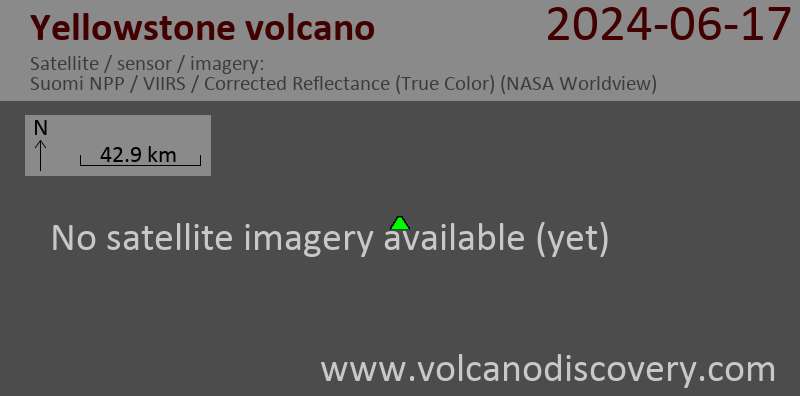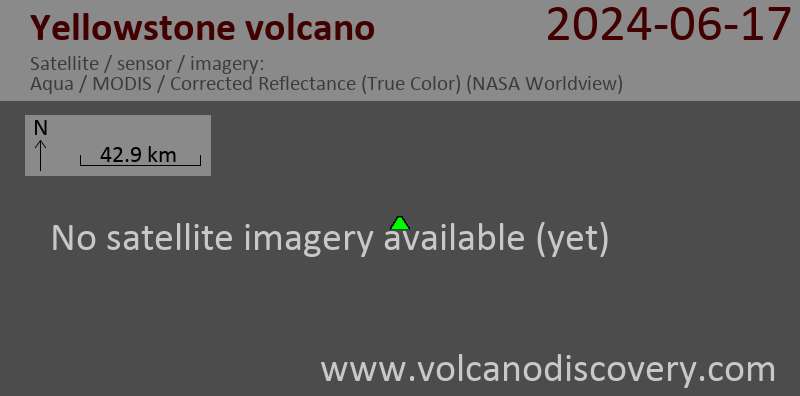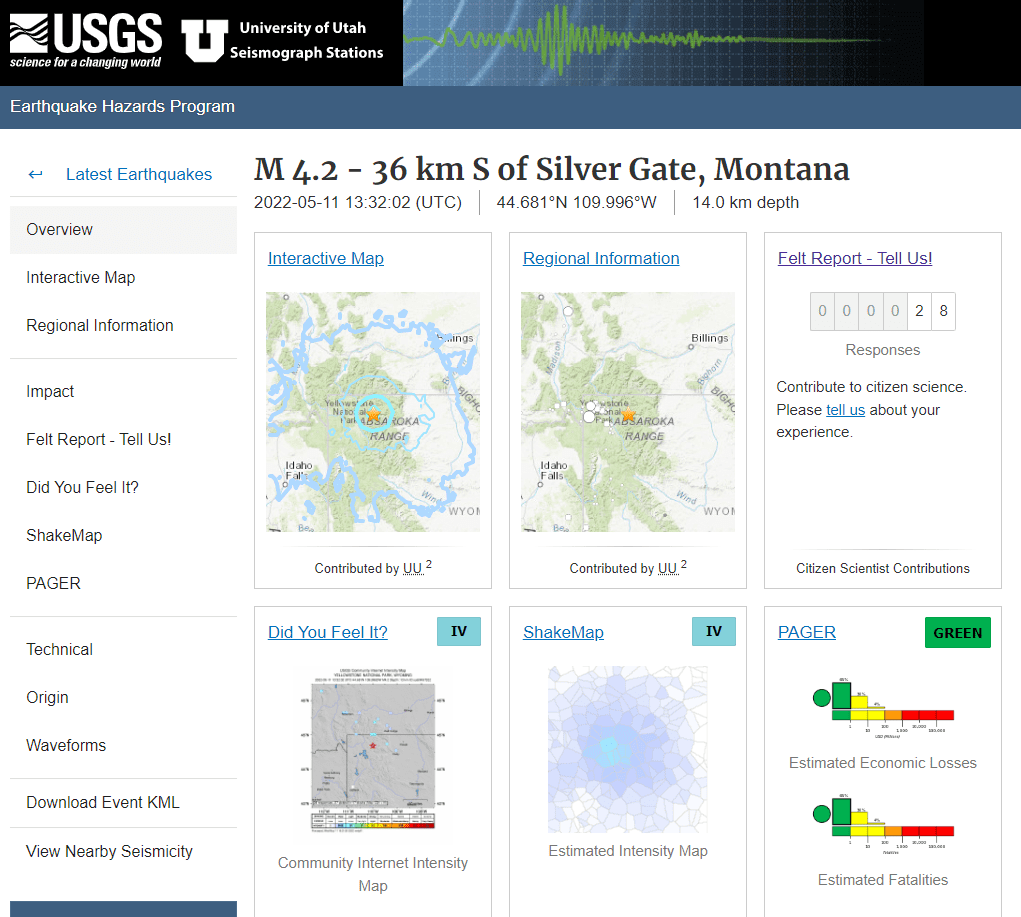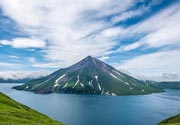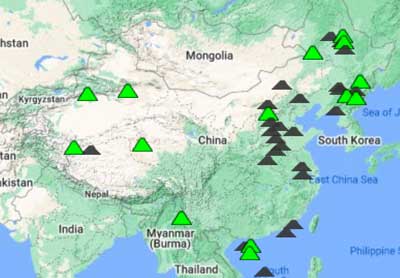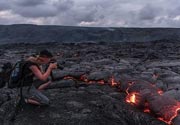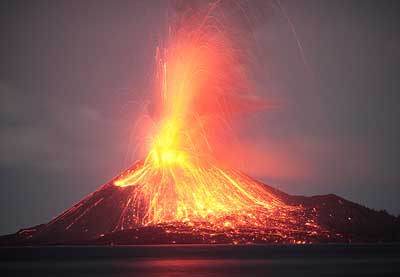Yellowstone Volcano
Wyoming, USA, 44.43°N / -110.67°W
Current status: normal or dormant (1 out of 5)
Yellowstone is one of the largest known volcanoes in the world and the largest volcanic system in North America. The volcano is found above an intra-plate hot spot that has been feeding the magma chamber underneath Yellowstone for at least 2 million years.
The giant caldera is the product of large-scale collapse of the crust after 3 so-called ultra-Plinian or super-volcano eruptions - large explosive events that erupt several hundreds to few thousands of cubic km of magma. These eruptions took place 2.1, 1.3 and 0.64 million years ago.
Yellowstone is also the world's largest hydrothermal system. It contains 182 geysers, mud pools and fumaroles. The most famous feature in Yellowstone is Old Faithful Geyser.
Future super-volcano eruptions at Yellowstone?
Yellowstone's magma chamber is believed to be still active and contain at least 15,000 cubic km of melt.
It cannot be ruled out, nor predicted that there will be another super-volcano eruption at Yellowstone in some (geologic) future.
In recent years, the caldera has been studied and is being monitored more closely. In recent years, Yellowstone has been showing unrest in the form of deformation, ground uplift, temperature changes, and seismic swarms, all of which have been followed with great interest and rising some concern. 70 small earthquake swarms were recorded at Yellowstone volcano between 1983 and 2006. On the other hand, such activity is probably entirely normal for a large dormant super-volcano.
Despite the unrest, there is currently no reason to believe that these are precursors to another large super-volcano eruption to happen in the nearer future (years to decades). More likely, these are normal activities in dormant stages of large active volcanic systems. In addition, most of the activity can be related to the hydrothermal system rather than the magma chamber itself.
Statistically, even though the interval of time lapsed since the last such eruption is similar to the intervals separating the past 3 eruptions, statistical likelihood that such an event will repeat itself in the next few 100 years is very low. Unfortunately, most media reports in recent years have been exaggerating this risk greatly.
Yellowstone volcano eruptions: 1350 BC ± 200 years
caldera-forming eruptions 70,000 BP, 160,000 BP, and 640,000 years ago (BP)
Latest nearby earthquakes
| Time | Mag. / Depth | Distance / Location | |||
| May 15, 01:46 pm (Denver) | 0.5 12 km | Info | |||
| May 15, 01:39 pm (Denver) | 0.7 11 km | Info | |||
| May 15, 01:36 pm (Denver) | 0.7 9.5 km | Info | |||
| Saturday, May 11, 2024 GMT (1 quake) | |||||
| May 11, 10:44 am (Denver) | 1.5 4.4 km | 14 km (8.5 mi) to the NE | Info | ||
| Tuesday, May 7, 2024 GMT (1 quake) | |||||
| May 7, 06:28 am (Denver) | 1.8 1 km | 8.8 km (5.5 mi) to the SE | Info | ||
| Monday, May 6, 2024 GMT (1 quake) | |||||
| May 5, 06:53 pm (Denver) | 1.0 12 km | Info | |||
Background
The Yellowstone Plateau developed through 3 volcanic cycles over 2 million years that included some of the world's largest known eruptions. Eruption of the >2450 km3 Huckleberry Ridge Tuff about 2.1 million years ago created the more than 75-km-long Island Park caldera.The second cycle concluded with the eruption of the Mesa Falls Tuff around 1.3 million years ago, forming the 16-km-wide Henrys Fork caldera at the western end of the first caldera.
Activity then shifted to the present Yellowstone Plateau and culminated 640,000 years ago with the eruption of the >1000 cu km Lava Creek Tuff and the formation of the present 45 x 85 km caldera.
Resurgent doming subsequently occurred at both the NE and SW sides of the caldera and voluminous (1000 km3) intra-caldera rhyolitic lava flows were erupted between 150,000 and 70,000 years ago.
No magmatic eruptions have occurred since the end of the Ice Age, but large hydrothermal eruptions took place near Yellowstone Lake during the Holocene.
Eruptions of Yellowstone volcano
In January-February 2010 the second largest recorded earthquake swarm was recorded at Yellowstone, with over 1800 tremors, the largest being magnitude 3.8 and felt in the park and surroundings. USGS scientists believe that most of the earthquakes were tectonic in origin caused by regional extension, while others were caused by geothermal activity.
Between 26 and 31 December 2008, an earthquake swarm with over 250 events occurred under Yellowstone Lake, three to six miles south-southeast of Fishing Bridge. The largest earthquake was a magnitude 3.9 at 10:15 pm MST on 27 December. 9 earthquakes measured between M3 and M3.9 and 24 between M2 to M2.9. Some of the quakes were felt in Yellowstone National park.
Changes in Norris Geyser Basin were observed in 2003 and hiking trails were closed as safetyl measures. New fumaroles were observed and some geysers had elevated temperatures.
Yellowstone National Park is well known for its geysers, colorful springs and scenic landscapes:
Old Faithful Area
Features include Upper Geyser Basin, Lower Geyser Basin, Midway Geyser Basin, Lone Star Geyser Basin, Shoshone Geyser Basin, Craig Pass/Isa Lake, and many waterfalls.
Norris Geyser Basin
This area has the hottest geothermal vents at Yellowstone. Features include Roaring Mountain, Gibbon River, Virginia Cascades, and Norris-Canyon Blowdown.
Mammoth Hot Springs
Travertine terraces created by hot springs flowing up through limestone. Hydrocarbon ions combine with calcium to precipitate as travertine. Features of the area include Gardner River Canyon, Boiling River, Mt. Everts, and Bunsen Peak.
Madison Area
Interesting features include the colorful lake Artist Paint Pots, Gibbon Falls, Monument Geyser Basin, Madison River, Terrace Springs, Firehole River, Firehole Canyon Drive and Firehole Falls.
Other Interesting Park Features
Yellowstone Lake, Abyss Pool, Fishing Cone, Isa Lake, Heart Lake, DeLacy Creek, Factory Hill, Lewis River, Red Mountains, Riddle Lake, Shoshone Lake, Snake River, Mud Volcano/Sulphur Caldron, Hayden and Pelican Valleys, Natural Bridge, Grand Canyon of the Yellowstone, Mt. Washburn, Tower Fall, and Calcite Springs.





